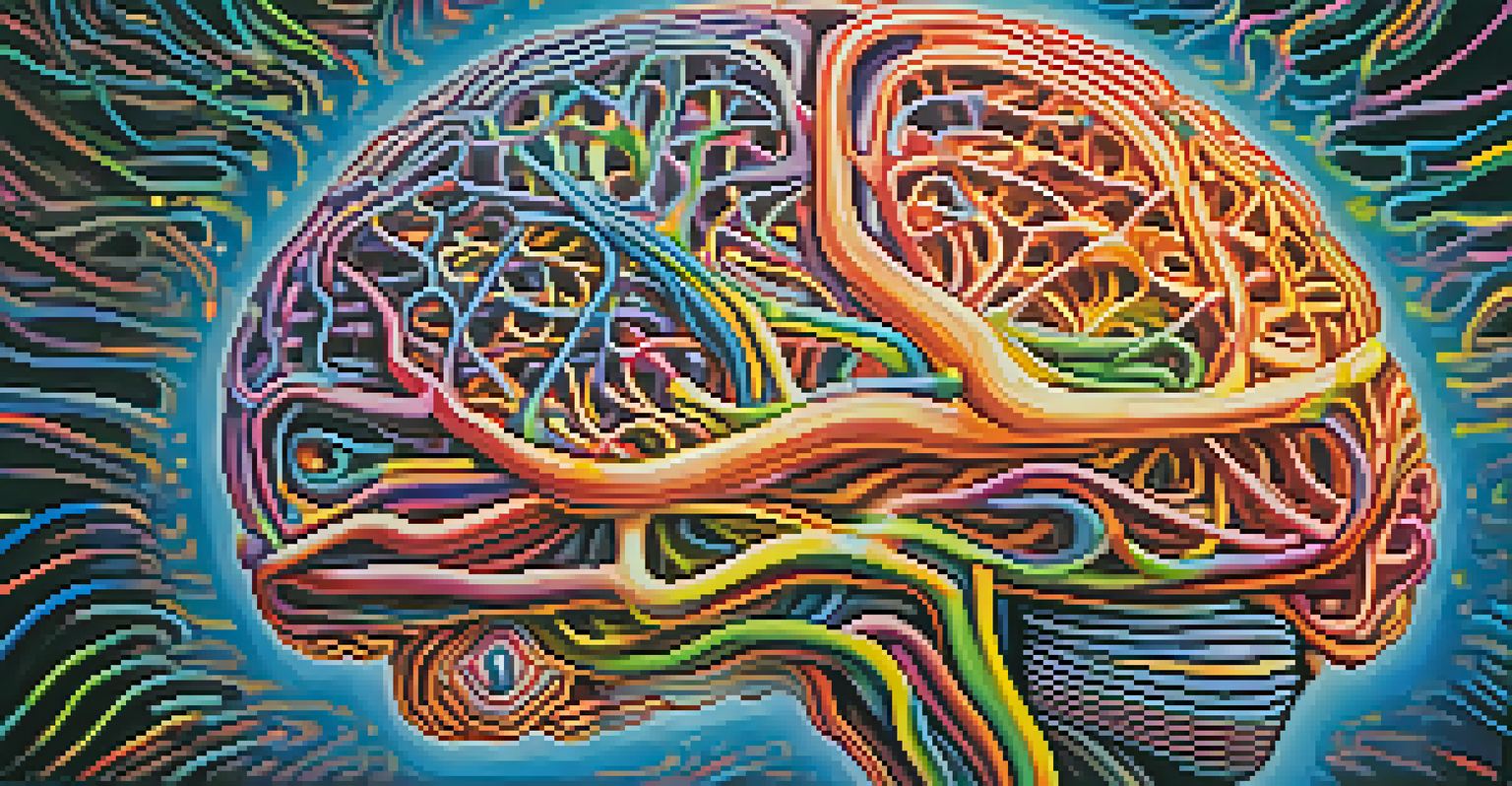The Science Behind Hallucinogens and Their Effect on Dreams

What Are Hallucinogens and Their Historical Context?
Hallucinogens are substances that alter perception, mood, and thought. They have been used for centuries in various cultures, often in spiritual or healing rituals. Examples include psilocybin mushrooms, LSD, and ayahuasca, each with a unique chemical structure and effects on the brain.
The use of hallucinogens as therapeutic tools is a promising frontier in understanding mental health and consciousness.
Historically, these substances have played significant roles in indigenous practices and modern psychotherapy. In recent years, there's been a resurgence of interest in their potential therapeutic benefits, particularly for mental health disorders. This historical context is essential for understanding their impact on human consciousness and dreams.
As we explore the science behind hallucinogens, it’s crucial to recognize their dual nature: both as powerful tools for introspection and as substances that can lead to unpredictable experiences. This duality sets the stage for how they potentially influence our dream states.
How Do Hallucinogens Affect the Brain?
Hallucinogens primarily affect receptors in the brain that process serotonin, a neurotransmitter linked to mood and perception. When these receptors are activated, the brain experiences altered sensory perceptions and emotional responses. This chemical interaction can lead to vivid visual and auditory experiences that extend into dreaming.

Research suggests that hallucinogens can increase neural connectivity, allowing different regions of the brain to communicate more freely. This enhanced connectivity may explain why users often report profound insights and creative thoughts during and after their experiences. It opens a window into understanding how dreams might be influenced by such shifts in brain activity.
Hallucinogens Influence Dreams
The use of hallucinogens can lead to more vivid and meaningful dream experiences, reflecting the altered states of consciousness they induce.
Interestingly, the effects of hallucinogens can vary greatly from person to person. Factors such as dosage, environment, and individual psychology play a significant role in determining how these substances alter a person's mental state, including their dreaming patterns.
The Connection Between Hallucinogens and Dreams
The link between hallucinogens and dreams lies in their ability to alter consciousness. Both experiences involve a departure from ordinary reality, allowing for deep introspection and exploration of one's psyche. Many users report that their dream experiences are more vivid and meaningful after consuming hallucinogens, suggesting a connection worth exploring.
Dreams are the royal road to the unconscious, and hallucinogens can provide insights that enhance our understanding of this realm.
One theory is that hallucinogens may induce a temporary state similar to REM sleep, the phase where most dreaming occurs. This overlap could explain why some users experience dream-like states while awake. In essence, the mind's boundaries can blur, facilitating a crossover between waking experiences and dreaming.
Moreover, studies have shown that hallucinogens can enhance creativity and problem-solving abilities. This heightened creativity may carry over into dreams, resulting in unique dream content that reflects the user's thoughts and feelings during their hallucinogenic experience.
Dreams as Reflections of Hallucinogenic Experiences
Dreams often serve as a canvas for our subconscious thoughts and emotions. When influenced by hallucinogens, these dreams can take on a surreal quality, mirroring the intense visuals and feelings experienced during a trip. This reflects how our mind integrates and processes these profound experiences.
For instance, someone who has taken psilocybin might dream of fantastical landscapes or encounter symbolic figures that represent personal challenges. Such dream imagery can be a way for the brain to make sense of the insights gained during the hallucinogenic experience.
Therapeutic Potential of Hallucinogens
Research highlights the potential of hallucinogens to aid in the treatment of mental health conditions by facilitating emotional insights during both wakefulness and dreaming.
This interplay between hallucinogenic experiences and dreams emphasizes the therapeutic potential of these substances. By exploring the content of dreams post-experience, individuals may uncover deeper truths about themselves and their emotional states.
Potential Therapeutic Benefits of Hallucinogens
Recent studies have highlighted the potential therapeutic benefits of hallucinogens for mental health conditions like PTSD, anxiety, and depression. The insights gained during the hallucinogenic experience can lead to breakthroughs in understanding and coping with one's emotions. This therapeutic journey often continues into the dream state, where unresolved issues may surface.
Therapists sometimes use hallucinogens in controlled settings to facilitate discussions about dreams and emotional experiences. The profound insights gained during these sessions can lead to significant personal growth and healing. For many, this process helps bridge the gap between conscious thought and the subconscious mind, revealing hidden fears and desires.
As research continues to evolve, the integration of dreaming and hallucinogenic experiences may play a pivotal role in future therapeutic practices. The potential for healing through both conscious exploration and dream analysis is an exciting frontier in mental health treatment.
Risks and Considerations of Using Hallucinogens
While hallucinogens offer potential benefits, they also come with risks. The unpredictability of the experience can lead to anxiety, paranoia, or other negative psychological effects. It's essential for individuals to approach these substances with caution and awareness of their mental health history.
Additionally, the context in which hallucinogens are used greatly impacts their effects. A supportive environment and the presence of experienced guides can enhance positive outcomes. Conversely, a chaotic or unsafe setting can lead to distressing experiences that may carry over into dreams and waking life.
Risks of Hallucinogen Use
While hallucinogens can offer benefits, they also pose risks, especially when used in unsafe environments or by individuals with certain mental health conditions.
It's vital to understand that not everyone is suited for hallucinogen use. Individuals with a history of mental illness or those currently taking certain medications should consult healthcare professionals before considering these substances. Safety and informed decision-making must always come first.
The Future of Hallucinogen Research and Dream Studies
The future of hallucinogen research is promising, with increasing interest in their potential benefits for mental health and understanding consciousness. As more studies emerge, we may gain deeper insights into how these substances interact with brain function and dreaming. This research could pave the way for new therapeutic practices that incorporate both hallucinogens and dream analysis.
Moreover, as societal perceptions of hallucinogens shift, we may see more open discussions about their use. This could lead to more rigorous scientific exploration and a better understanding of their effects on both waking life and dreams. The integration of these elements could revolutionize how we approach mental health treatment.

Ultimately, the intersection of hallucinogens and dreams presents a fascinating area of study. As we continue to explore this connection, we may unlock new pathways to understanding the human mind and the mysteries of our dream world.